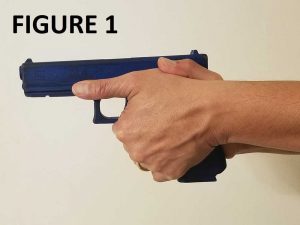 Many officers do not believe that they can actually “call their shots” or fix shooting errors “on the fly.” That is why this technique is usually an eye-opener for officers during pistol training classes. In my last article, we discussed “reset in recoil” and how to better control your shot pattern on the “Y” axis (up/down). Today, we are going to talk about controlling your shots on the “X” axis (left/right). I am going to discuss a couple of nuances that get overlooked within the widely used thumbs-forward grip technique (Figure 1). These nuances can help you increase accuracy and fix shooting placement errors while firing, even under stress, thus being able to “call your shots.”
Many officers do not believe that they can actually “call their shots” or fix shooting errors “on the fly.” That is why this technique is usually an eye-opener for officers during pistol training classes. In my last article, we discussed “reset in recoil” and how to better control your shot pattern on the “Y” axis (up/down). Today, we are going to talk about controlling your shots on the “X” axis (left/right). I am going to discuss a couple of nuances that get overlooked within the widely used thumbs-forward grip technique (Figure 1). These nuances can help you increase accuracy and fix shooting placement errors while firing, even under stress, thus being able to “call your shots.”
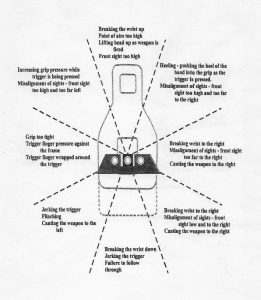 If you have some room to level up your pistol skills by correcting shots that push to one side of the target, you are going to be interested in trying this technique. First, you will need to conduct an initial live
If you have some room to level up your pistol skills by correcting shots that push to one side of the target, you are going to be interested in trying this technique. First, you will need to conduct an initial live
-fire shooting assessment to find out if this technique would benefit you. Visit tinyurl.com/bsu2arpn and print the 8.5” x 11” ATG “Call Your Shot” target from ArmitageTactical.com. You will need at least two of these targets to complete the training. Next, follow the directions for the initial live-fire assessment.
Initial live-fire assessment
Put up one of the ATG “Call Your Shot” targets and stand at the 7-yard line. Next, fire approximately five sets of three rounds each. This should be done in controlled succession with a two-second count in between each shot fired (e.g., first shot: one one-thousand, two one-thousand; second shot: one one-thousand, two one-thousand; third shot: end of first set). Do this while aiming at the center square on the target. Repeat this process until you have fired at least one full magazine (totaling approximately 15 rounds). Next, look at the target. If you see a shot pattern that reveals at least one-third of your hits (five rounds) noticeably gravitating to your weak/support side (three or more grid squares away from the vertical center line), you will greatly benefit from this technique. Additionally, if your hits are pushing toward the edge of the grid (on the weak/support side), you can reset on the 5-yard line and restart the test from a closer position. This will lessen the deviation and make the drill more manageable for evaluating purposes. However, if your shots are hitting in all different areas of the target, you will need to rework your upper body platform (including grip) and deal with any anticipation issues before you would notice a real difference utilizing this drill. Fortunately, more training articles addressing those specific dilemmas (upper body platform/anticipation) will be coming out soon.
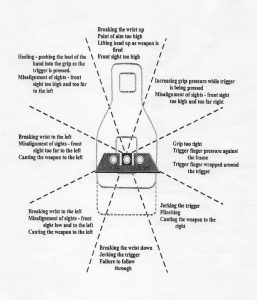 Next, ask yourself a few questions. Where do most missed rounds hit for right-handed shooters? If you answered low or left of center, you are correct. And of course, it is just the opposite for left-handed shooters (low or right of center). But why do most misses end up in those two areas? For the most part, officers understand that when rounds consistently hit low of center, the likely culprit is “anticipation.” However, most officers cannot determine with 100% confidence why their rounds continue to push to their weak/support side. The standard answer they hear is “jerking or slapping the trigger.” However, when the officer practices slowly pressing the trigger, their hits are still noticeably pushing to that same side, proving that “slapping the trigger” is not the source of the problem. Moreover, you have probably seen other factors listed on different versions of a pistol shooting correction chart, like the ones pictured above (Figure 2 and Figure 3).
Next, ask yourself a few questions. Where do most missed rounds hit for right-handed shooters? If you answered low or left of center, you are correct. And of course, it is just the opposite for left-handed shooters (low or right of center). But why do most misses end up in those two areas? For the most part, officers understand that when rounds consistently hit low of center, the likely culprit is “anticipation.” However, most officers cannot determine with 100% confidence why their rounds continue to push to their weak/support side. The standard answer they hear is “jerking or slapping the trigger.” However, when the officer practices slowly pressing the trigger, their hits are still noticeably pushing to that same side, proving that “slapping the trigger” is not the source of the problem. Moreover, you have probably seen other factors listed on different versions of a pistol shooting correction chart, like the ones pictured above (Figure 2 and Figure 3).
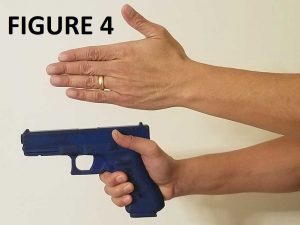 And this is where I really go against the grain as a trainer. You might even say I am speaking pistol blasphemy. However, if you conduct the tests below, it will be abundantly clear that the trigger (or the other listed factors) is not the source of the problem. So if you do not mind humoring me for a minute, let me explain.
And this is where I really go against the grain as a trainer. You might even say I am speaking pistol blasphemy. However, if you conduct the tests below, it will be abundantly clear that the trigger (or the other listed factors) is not the source of the problem. So if you do not mind humoring me for a minute, let me explain.
The key to the whole issue is balanced resistance, not trigger press (or anything else listed on those charts). It is all about balancing pressure and isometric tension within your grip. For example, if I utilized a shooting vise to sight in my pistol, the vise would need to provide an equal amount of pressure on both sides of the gun in order to keep it stable during the firing process. Otherwise, the gun would shift while firing and the shot pattern would be inconsistent. Therefore, I tighten each side of the vise grip accordingly, looking for the proper balance of pressure on both sides of the gun. Only then can I produce predictable and repeatable hole-on-hole hits on the target. Unfortunately, we do not work like a vise and inherently provide more pressure from our strong side when firing. It is just natural. And the strong side pressure increases even more when we are firing under stress. Again, natural. Therefore, increasing isometric tension on your weak/support side will help equalize the resistance on the gun, which is the missing x-factor that solves this specific
problem.
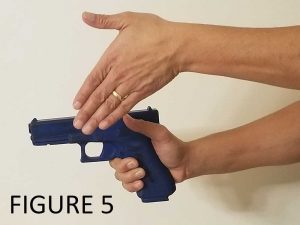 To make this concept clear, we are going to do a dry-fire front-sight alignment test. Once your weapon has been safely cleared (or use an inert training gun), grip the pistol with your strong hand as you normally would. Then, with your support hand in a standard “handshake” position (Figure 4), tilt your wrist approximately 35 degrees forward so that your thumb is “truly” pointing in a forward direction (Figure 5). Now, wrap your support hand fingers around the grip of the gun and place your thumb along the side of the frame, keeping the support thumb pointed forward (Figure 6). This “true” thumbs-forward grip may feel awkward at first if you are not used to it. And you might feel like adjusting your thumb upward in a diagonal position to make it more comfortable (Figure 7). However, try to avoid this because it will affect your ability to “call your shots.”
To make this concept clear, we are going to do a dry-fire front-sight alignment test. Once your weapon has been safely cleared (or use an inert training gun), grip the pistol with your strong hand as you normally would. Then, with your support hand in a standard “handshake” position (Figure 4), tilt your wrist approximately 35 degrees forward so that your thumb is “truly” pointing in a forward direction (Figure 5). Now, wrap your support hand fingers around the grip of the gun and place your thumb along the side of the frame, keeping the support thumb pointed forward (Figure 6). This “true” thumbs-forward grip may feel awkward at first if you are not used to it. And you might feel like adjusting your thumb upward in a diagonal position to make it more comfortable (Figure 7). However, try to avoid this because it will affect your ability to “call your shots.”
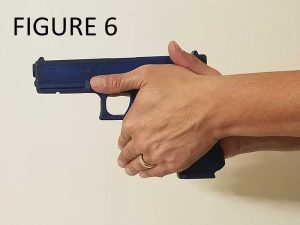 After your grip is in place, fully extend your arms while looking down the sights and prepare to dry fire. Next, I want you to press and hold the trigger all the way to the rear. While holding the trigger against the rear wall, keep your eyes on the front sight. Now add extraordinarily strong rearward pressure to the trigger five to six times as if you were firing the weapon. However, try not to release the trigger from the rear wall while doing this so you do not have to reset the gun each time (mainly striker-fired pistols).
After your grip is in place, fully extend your arms while looking down the sights and prepare to dry fire. Next, I want you to press and hold the trigger all the way to the rear. While holding the trigger against the rear wall, keep your eyes on the front sight. Now add extraordinarily strong rearward pressure to the trigger five to six times as if you were firing the weapon. However, try not to release the trigger from the rear wall while doing this so you do not have to reset the gun each time (mainly striker-fired pistols).
As you are replicating these trigger presses, you will notice that your front sight is moving. Which way is it moving? If the front sight is moving to your weak/support side, your grip is stable (Figure 8). If the front sight is moving in any other direction, you will need to restabilize and strengthen your grip until the front sight is only moving to your weak/support side. (Note: slightly low on that side is also acceptable; see Figure 8.)
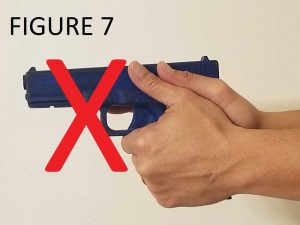 Once you see the front sight consistently moving to your weak/support side, you are ready for the final nuance of this technique. Take your support side thumb and press it into the side of the frame. Then, begin your trigger presses again. But this time, add pressure with your support side thumb against the frame until your front sight stabilizes. Add as much pressure as needed until the sight is no longer moving and stays in proper sight alignment throughout the presses. Once the front sight is no longer moving, you have achieved a completely stabilized grip and are now on the path to controlling your shots. Next, we are going to translate this to live fire with the final shooting test.
Once you see the front sight consistently moving to your weak/support side, you are ready for the final nuance of this technique. Take your support side thumb and press it into the side of the frame. Then, begin your trigger presses again. But this time, add pressure with your support side thumb against the frame until your front sight stabilizes. Add as much pressure as needed until the sight is no longer moving and stays in proper sight alignment throughout the presses. Once the front sight is no longer moving, you have achieved a completely stabilized grip and are now on the path to controlling your shots. Next, we are going to translate this to live fire with the final shooting test.
Final live-fire test
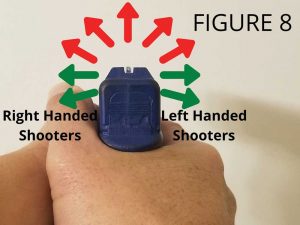 Put up a fresh ATG “Call Your Shot” target, and once again, stand at the 7- or 5-yard line. Get into a proper firing position and ensure that your grip is firm and stable. Fire the first round at the center square. Note the hit point (but do not worry if you are hitting a little low on the target, just focus on the left/right axis). If the round hit left of center (right-handed shooter) or right of center (left-handed shooter), restabilize your grip. After restabilizing, add steady pressure with your support side thumb to the side of the frame. Now, make sure you have proper sight alignment and slowly break the trigger on the second round. That second hit should be closer to the vertical center line, hopefully moving into the square. If the second round did not shift inward or did not shift enough, add more thumb pressure to the frame and slowly fire again. Repeat this one-round-at-a-time process until you have finished off another full magazine. By the end of the magazine, you should have noticed a difference. You should have noticed a more fully stabilized grip and been able to place more rounds closer to the vertical center line. (Note: You are going to have to remind yourself multiple times to keep steady thumb pressure on the support side frame throughout. And every so often during the drill, you may have to reset and restabilize your grip.)
Put up a fresh ATG “Call Your Shot” target, and once again, stand at the 7- or 5-yard line. Get into a proper firing position and ensure that your grip is firm and stable. Fire the first round at the center square. Note the hit point (but do not worry if you are hitting a little low on the target, just focus on the left/right axis). If the round hit left of center (right-handed shooter) or right of center (left-handed shooter), restabilize your grip. After restabilizing, add steady pressure with your support side thumb to the side of the frame. Now, make sure you have proper sight alignment and slowly break the trigger on the second round. That second hit should be closer to the vertical center line, hopefully moving into the square. If the second round did not shift inward or did not shift enough, add more thumb pressure to the frame and slowly fire again. Repeat this one-round-at-a-time process until you have finished off another full magazine. By the end of the magazine, you should have noticed a difference. You should have noticed a more fully stabilized grip and been able to place more rounds closer to the vertical center line. (Note: You are going to have to remind yourself multiple times to keep steady thumb pressure on the support side frame throughout. And every so often during the drill, you may have to reset and restabilize your grip.)
Practice this live-fire test until you have placed all 15 rounds in the center square or at least within one to two grid squares (left/right) from the vertical center line. To increase difficulty, add distance or additional stressors (e.g., faster shot times) and rework the drill. You will notice when more stress is introduced, the more resistance you will have to add to the support side in order to balance out the natural increase in pressure from the strong side. After consistent practice, this technique will be second nature and become part of your natural grip and press process.
If you have any questions, please get in touch. Otherwise, #staysafe and #stayready.
As seen in the July 2021 issue of American Police Beat magazine.
Don’t miss out on another issue today! Click below:






